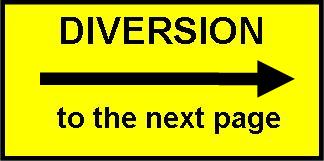How to build a model car.
If you are just starting car modelling, or are thinking about it, have a read through this article. Over the next few pages we will take you through the steps of making a model car, the things you’re likely to encounter and the basic tools and equipment you will need to make a good model at the first try.
If you have questions on anything, please e-mail us.
Your first kit
I expect you already have a kit but, if your planning on getting one, consider your options carefully.
You don’t want a kit that’s too easy and leaves you unsatisfied, but you don’t want one too hard so you loose heart and don’t finish it.
Some kits have “skill level” guides on them, some tell you approximately how long the model takes to build or the number of parts contained in the kit. None of these systems are that reliable in deciding which kit to buy. If you come up against something you’re unsure of or the instructions seem unclear, it won’t matter how many parts are in the kit.
We would recommend you start with a model from the older Tamiya or Fujimi ranges. These kits are good quality, have good clear instruction sheets and are properly engineered, so the parts fit well without lots of fiddling around filing and sanding. Their plastics respond predictably to cements and the casting detail is crisp which helps when you come to the detail painting. They really are the most straightforward kits to cut your modelling teeth on.
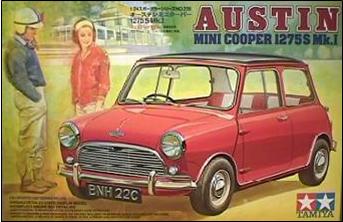
Tamiya’s mini kit has had several incarnations but remains a very sound kit. Tamiya have always been at the fore front of moulding technology, so much so that some of their latest kits have become a little too technical for the beginner, that is why we suggest some of the ‘80s or 90s releases (or re-releases), such as the mini, to gain some experience and confidence.
Instructions!
The first step when making any model kit (having opened the box!) is to read the instructions and familiarise yourself with the parts. It sounds so obvious and is nearly always printed on the instruction sheet, but this “Before you begin” notice is often ignored. Please,
READ THE INSTRUCTIONS.
Please pay particular attention to safety information. Model making brings you into contact with things that can harm you.
In the immediate time scale serious cuts from knives or allergic, even toxic, reactions to chemicals can occur. In the long term lung and bowel damage from repeated exposure to plastic, resin or metal dusts and other chemical vapours can cause illnesses too.
In this health and safety conscious age you will find safety notices on almost everything you buy. Follow the advice to live a long, happy, injury free modelling life.
As well as the safety advice the instructions have a key to tell you what certain symbols mean. These allow the manufacturers to keep instructions clear, uncluttered by words and repetition through use of small symbols, recognisable whatever the builders own language.
The only slight flaw in the plan is that the symbols are not universal, each manufacturer uses different symbols
Revell’s instruction key, some of the symbols are easy to interpret while others need explaining; in a multitude of languages.
Likewise for the painting guide key.
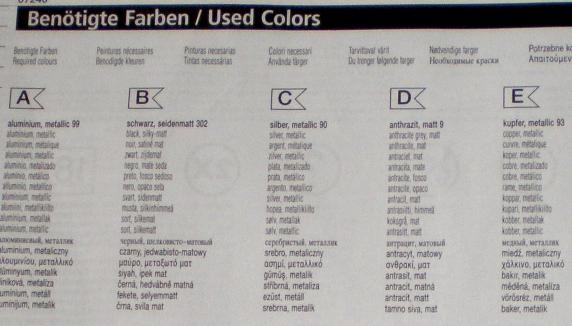
Children under the age of 10 should not be left unsupervised while model making, children older than 10 may still need to be supervised depending on their maturity. Parents must take responsibility for deciding what their childrens capabilities are.
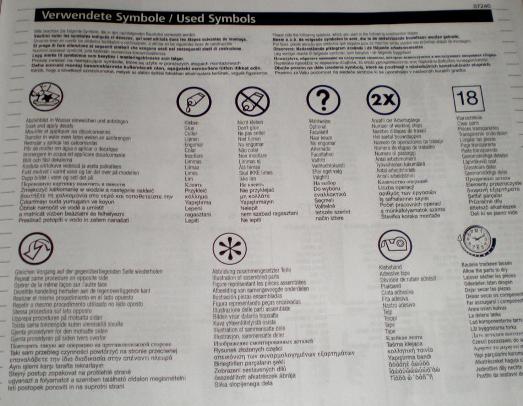
The instructions sometimes have brief advice information which in pictorial form speak for themselves, in the end the information gleaned from other modellers and experience gained by having a go are often the best teaching you can get.

The exploded drawing style has evolved but in essence remains the basis of all model kit instructions. Below you can see how the words have disappeared, replaced by part numbers, symbols and painting codes. It does keep the pictures uncluttered but I find I pencil in the colour of some of the less familiar paint numbers.
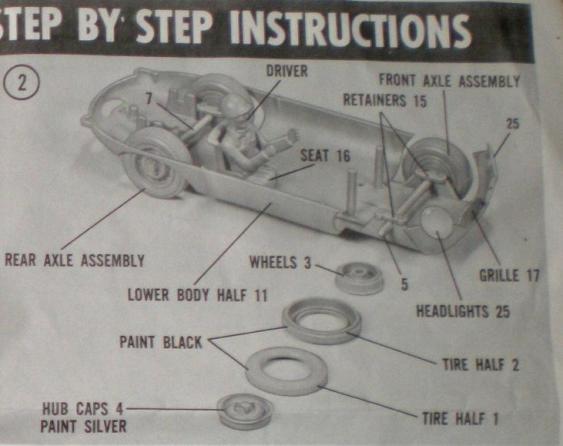
Usually there will be a summary of the subjects history and performance, some specifications and perhaps information on a specific paint colour, though this is not universal either. For some modellers researching the history of their model subject, and learning about it, are part of the lure of model making.
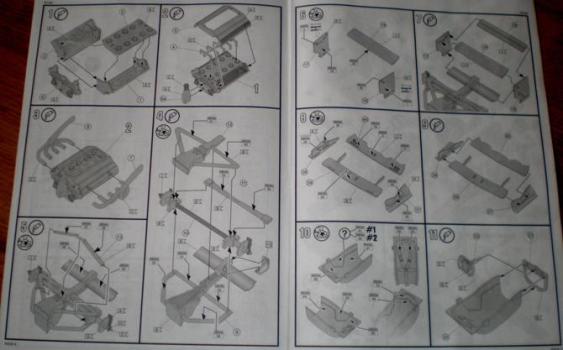
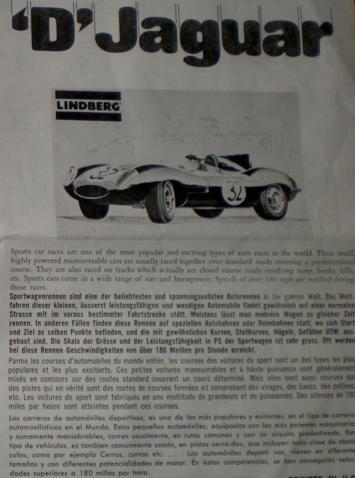
Before you dive into the building, check the parts off against the contents list. Most model kits have a contents list or plan of the sprues so you can ensure all the parts are present. You can combine this with reading the instructions and familiarising yourself with the parts
If there are any parts missing you have several options available depending on where you got the kit. If it was purchased new from a shop or dealer you may well be able to simply exchange it for another new kit, most countries now have consumer law to protect your rights.
If you obtained the kit from a second hand dealer or over the internet you may not be able to swap it for another one. Not because the seller is unwilling to help but he may not have another one to swap it with. In this case you may contact the kit manufacturer for their help. Most manufacturers will supply the parts needed, if they have them available, and often free of charge, but don’t take this for granted, it often helps to offer to pay any reasonable costs, post and packing and a small charge for the part/s. Please don’t abuse this service as it would spoil it for all the other modellers.
I have only once had a company charge me for replacement parts or decals.
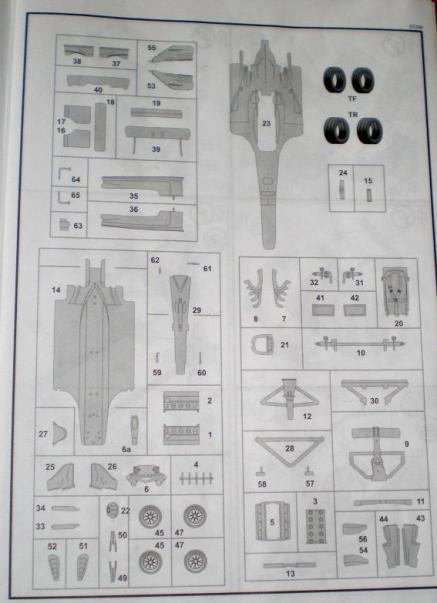
Kits can have large numbers of parts, sometimes moulded in different coloured plastic, clear and plated parts. There may even be photo etch parts in the newest kits which will require a different method of gluing them in place.
It pays to take the time to study the parts and ensure you are clear on the numbers and part identification.
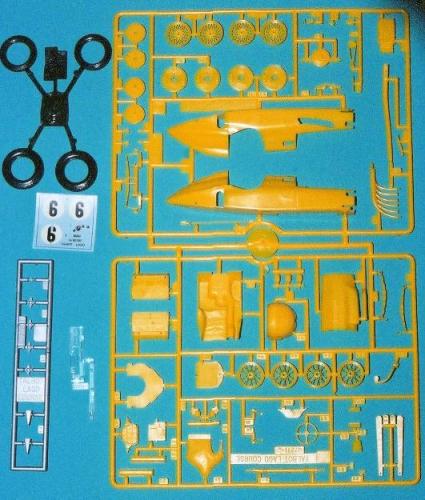
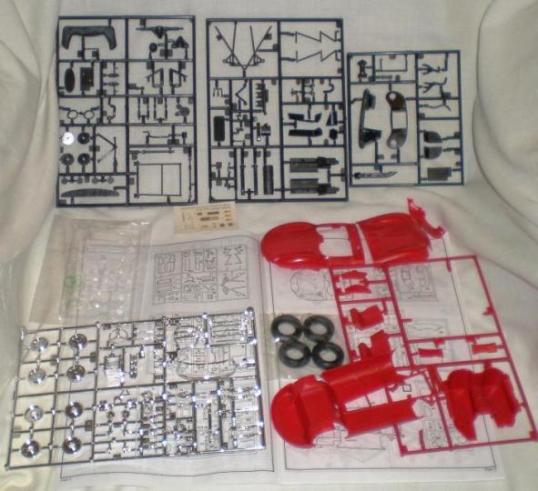
While you’re new to model making follow the instructions step by step. These are usually numbered in a logical sequence that will build a series of sub-assemblies, eventually bringing them all together and ending with the final exterior details.
The parts are numbered, but don’t be surprised to find that during step one you are using parts numbered much higher, not part 1 followed by 2 and so on. The part numbers identify the part not necessarily the sequence of assembly.
Only take off the parts you need for the step you are at. Left and right parts can be very similar and without the numbers to identify them it can be easy to mix them up, the numbers of the parts are usually on the sprue tree, not the part.

The best model makers I know have met spend a lot of time going over & over the instructions even though they have made lots of kits and are now able to manipulate the order in which they do things. Being familiar with the parts and understanding how they relate to each other will save time and upset later. The use of the instruction sheet, (reading and interpreting the instructions) is a basic skill which needs practicing just as much as the use of any other equipment or tool in the modellers arsenal.
We have already mentioned checking off the kit parts, the system of numbering parts and learning the relationship between parts before construction. Now we will go into things in a little more depth. As we said, the instructions usually follow a logical sequence but this sequence is produced around the building of the parts rather than the construction of a model. Now that sounds like the same thing but read on and you’ll see the subtle difference.
To most car modellers the most important thing on a car model is the most visible one, the paint finish. This is often a long process of patient preparation, finger prints and blemishes are to be avoided at all costs. The processes of painting will be covered later but the point here is that any fillers needed to eliminate join marks or defects in the main body parts need time to fully harden. Also the primer and paint finish need time to cure fully to avoid any handling causing figure print problems. Therefore the body is usually the place we start, rather than step one on the instruction sheet, which is often the engine or chassis, which can be attended to while the body and paint is hardening off.
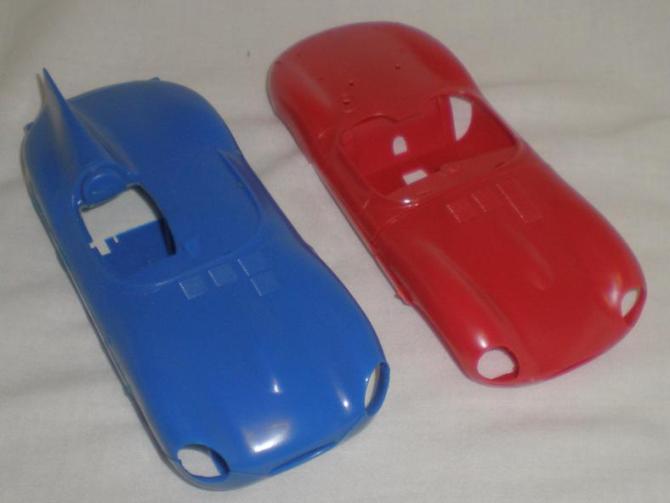
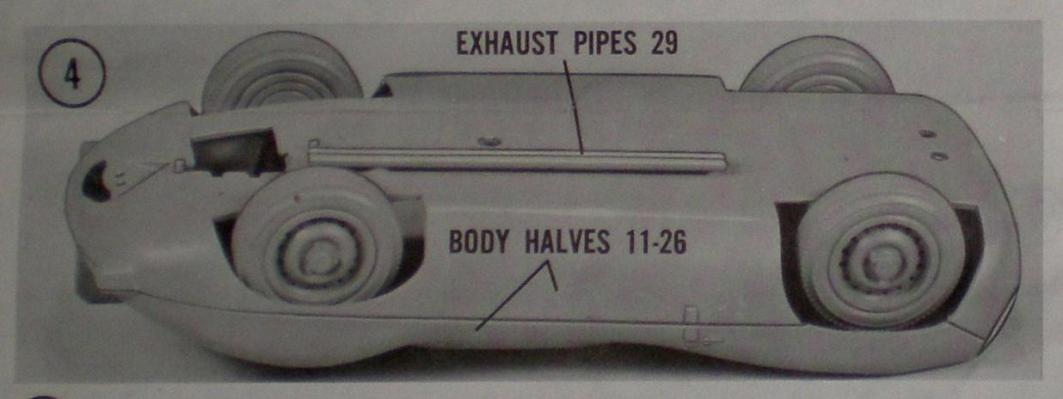
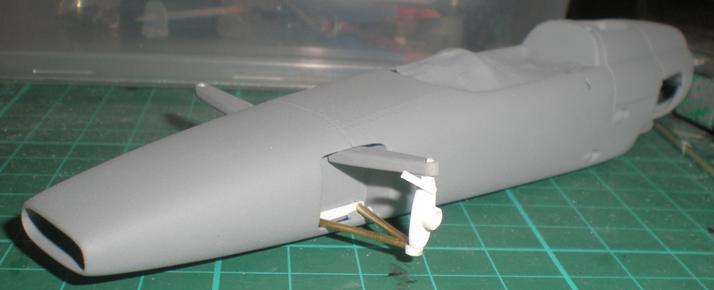
Here are some examples of the planning process, this time putting the body parts together. this often needs some pre-planning and the need for lateral thinking.
The ‘D’ type Jaguar bodies, left, are being tried for fit quality, and planning how to get rid of unwanted join lines. This is very important in order to achieve the illusion of reality we always look for. join lines down the sides of a model in places where there are none on the real car just look awful.
Instructions from the Lindberg ‘D’ Type Jaguar kit clearly show the body halves will have a join line all around the body work. While this join line is correct for the bonnet it will need sanding, filling and more sanding to make the join invisible around the rest of the body.
Clearly the internals and wheels are supposed to be put in before the body halves are joined meaning pre-planning is needed to overcome this
The BRM P261 has been put together and primed so defects can be rectified. Joint and mould lines have already been sanded away, filler has been used where needed and the body is ready for it's proper colour to be applied. To do this meant adding bulk heads and all cockpit interior before painting, followed by carefully masking of these areas.
These ideas or perhaps for later in your modelling career but even at the beginning it doesn't hurt to learn a few tricks of the trade.
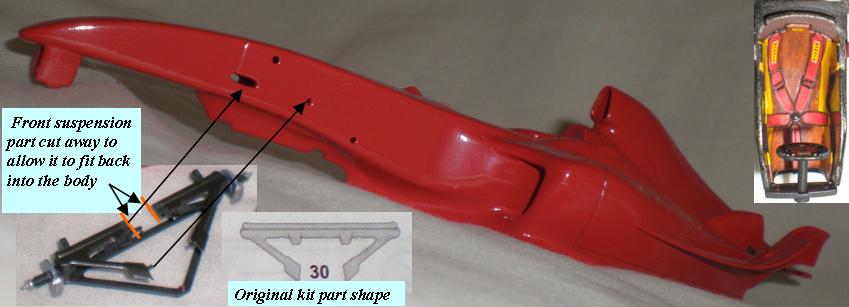
The Ferrari F2003GA has had all its main body parts put together, all the unwanted join lines filled and sanded, then primed, prepared and painted. The final polishing has also been done but decals will go later in the build to avoid and damage to them from repeated handling.
This model has required modifications to the front suspension assembly, which can now be attached under the tub and clipped into the holes in the sides with no join lines now visible. The cockpit will be slid into place from underneath.
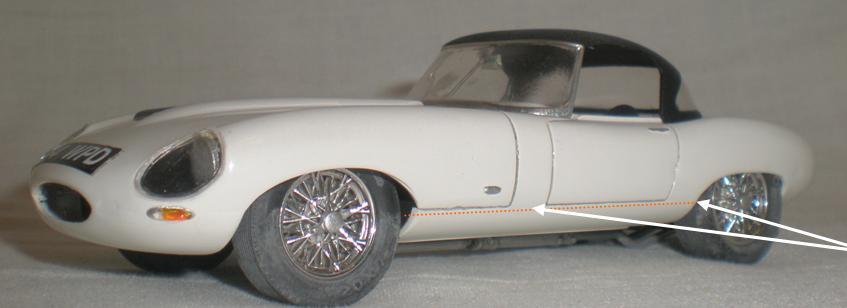
This ‘E’ type Jaguar kit had a join line just above our marked line.
While the join line is helpful in demarcating the bonnet and door it is not welcome in the two other locations. In order to put the two body parts together all the parts sandwiched between the two halves of the body must either be fitted first or modified so they can be added later.
Manipulating the instructions.
The main point is that dealing with the various issues means pre-planning. The body must be prepaired, filled, sanded and the painting completed to give a realistic finish. Then it’s all put aside to work on the other subassemblies while the paint finish hardens.
All these steps require planning at the beginning of the build and manipulation of the instructions. The instructions should not be ignored, simply adjusted to suit the needs of the model.
As you become more confident, and want to add more details, this redefining of the instruction steps becomes a more and more regular occurrence but always have the instruction sheet close at hand. Refer to it regularly and make your own steps list to keep you on track.
Research.
Just a quick word on research. Many modellers enjoy taking a look at the back ground of the model they’re building. This can be very interesting and you can find lots of pictures to help with details and colours, but you can be led astray by false facts and inaccurate refurbishments so if you do choose to go “in depth” try to find as much reference as you can so you can double check things.
Of course how much research you do is up to you, if building straight from the box gives you pleasure that’s just as relevant as anything else. This is a hobby for most of us and it’s the relaxation and pleasure that are the real aims of modelling.
When I saw this ‘D’ Type picture I instantly wanted to find a kit to allow me to make it, sometimes the research precedes the model when inspiration occurs!
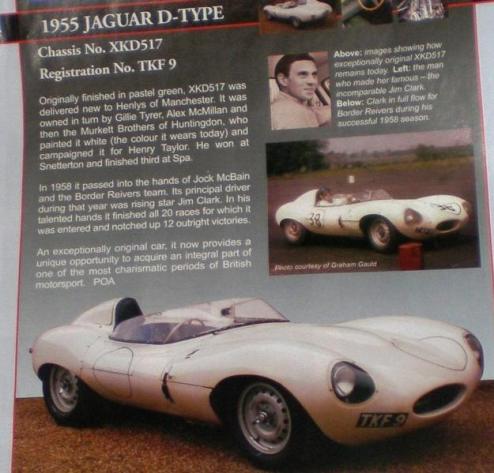
More preparation.
Although we are nearly ready to start building there is one more preparatory step, washing the parts. All moulded parts, whether they are plastic, resin, white metal or rubber will probably have mould release agents and other chemicals, from the production process or the chemicals they are made from, on them. These can interfere with the paint products and fillers later but also get on your hands and get spread around your home. If you like, wash the parts first and read the instructions, in depth, while the parts dry.
Wash the parts carefully, in a mild detergent solution in a large bowl. The parts can be washed on the sprue frame to avoid losing bits or mixing up the part numbers later in the build. Rinse in clean water then dab them dry with a tea-towel before finally letting them air dry.
Many modellers don’t bother with this step but to get the best results you need to put in the preparation time. Some modellers will wash the sub-assemblies they have built up before starting the painting, this is to remove any greasy, oily finger marks that occur while handling the parts during the construction processes.
Finally we are ready to do some building, I know it seems a long process just to get here but I promise you all the other steps are necessary. The quality of the final model is directly linked to the amount of time and effort put into preparation.
Modellers develop their own approach through experience gained over time. What works for one modeller may not be good for another.
Cutting parts from the sprue tree.
Once you have planned your build you will move on to cutting parts off the sprue tree (assuming you have washed the parts). Never twist or pull the parts off as you run the risk of damaging the parts.
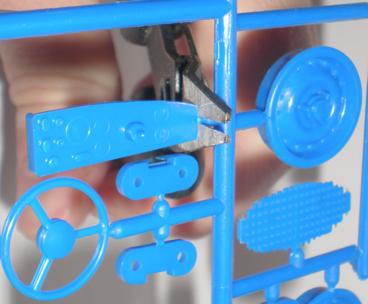
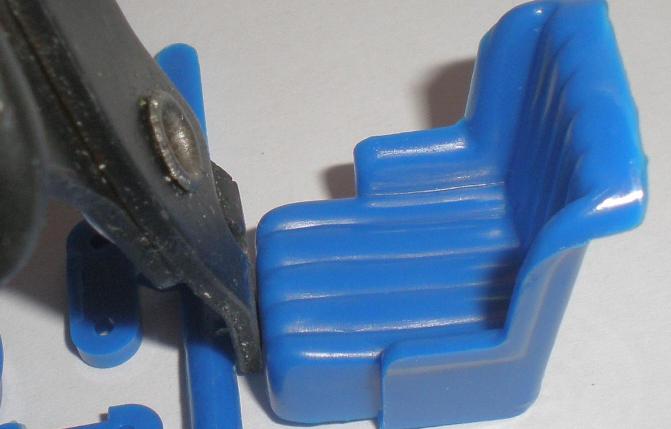
Remember all knives and cutters are potentially dangerous and must be handled with care
Always cut away from your body and hands, not towards you. Trim small amounts off at a time and avoid excerting large amounts of pressure to cut. Wrap tape around any exposed length of blade if it is not needed for the cut.
The best tool for this job are side cutters.
Put the flat side of the cutters to the part so you can clearly see what is happening as you cut. If possible avoid cutting right up against the part so any distortion is limited to the sprue not the kit part, this is especially important when cutting fine parts from the sprue.
Another method is to cut the part off with a knife. If you are going to use a knife make sure you cut on a hard surface protected by a cutting matt or thick cardboard. DO NOT CUT ON YOUR KNEES. Place the knife on the sprue close to the part, but not right up against it, as with the cutters. Use a rolling motion back and forth to ease your way through the sprue.
When cutting it is a good idea to keep one finger on the part to stop it flying away! (keep your finger away from the blade).
A quick word about knives.
Modelling knives come in lots of shapes and sizes these days but the most common are the Exacto knives. Generally speaking these are the best all round knives to have. These knives consist of simple handles which will hold a variety of blade shapes depending on the job at hand, they’re fairly hard wearing and quite precise enough for general use.
Swan-Morton surgical scalpels are similar in as much as differing blade shapes and sizes are available. However they are much finer and break under twisting motions or heavy pressure, so should not be used for such tasks.
The good old Stanley knife with it’s heavy weight blades is the best knife for the heavy jobs like cutting through thick plastic card, or removing parts from sprue that has thick gates. For your safety try to get one of the retractable blade type.
Only remove the parts for the step you are dealing with. In time you will become familiar enough with the parts and processes to cut off more parts but to start with keep things straight forward and easy.
In the future you may wish to buy a slide cutter. These are much more accurate and safer than using knives if you are going to be cutting sheet plastic, guillotine cutters can also be purchased, these are very good for repeated cutting jobs during scratch building as they can be set to cut at specific angles or widths.
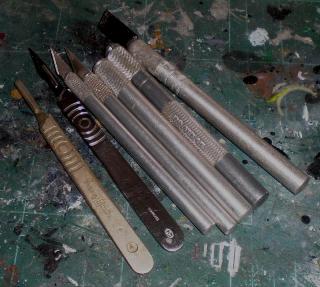
A selection of knives, Exacto style in two sizes to the right and two Swan Morton scalpel handles on the left. I've collected them together over the years and it is handy to have a few knives with different shapes of blade in to avoid the wasting of time swapping blades over all the time.
Note the messy background, everyone has spills. I keep a clean cutting matt for building work and this one for the messy jobs.
Checking each part.
Once you’ve cut off a part take a few seconds to examine it for defects.
Parts can have sink marks where the plastic has cooled and shrunk, this usually happens where large amounts of plastic are injected into one area of the mould but as the pressure is released once the injection process is stopped, and the sprue is removed from the mould, the plastic, and sometimes air trapped inside, cools and shrinks so the plastic sinks in on itself.
Another defect that can occur is ejector pin marks, while the sprue is still warm and soft in the mould ejector pins push the sprue tree out of the mould and sometimes leave impressions, as a mould gets worn these pins can become inaccurately set so they remain proud of the mould surface causing round impressions in the part, or they sit deep in their hole and the part gets an additional pillar of plastic formed on it.
As a mould wears out the two halves don't sit together as well as when it was new, this allows molten plastic to seep between the plates and leaves what we call flash. This is usually fairly thin and easy to remove but sometimes can be very thick and need to be carefully cut away.
The other defect most often seen is when the two halves of the mould don't meet accurately and one side of the part is out if line with the other. This can be very difficult to get rid of if the parts are round as scrapping the seam flat can leave a round sectioned part suddenly oval. Some exterior panels will probably need fillers to help restore the proper lines of the model.
Check for any warping in the chassis or body, attend to them now.
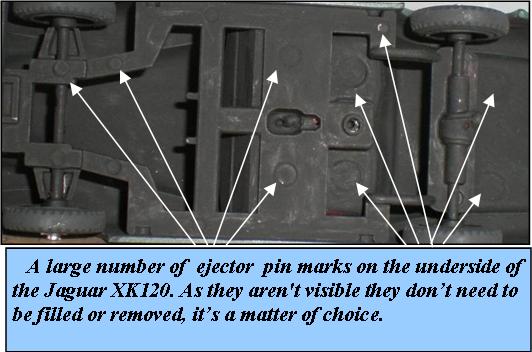
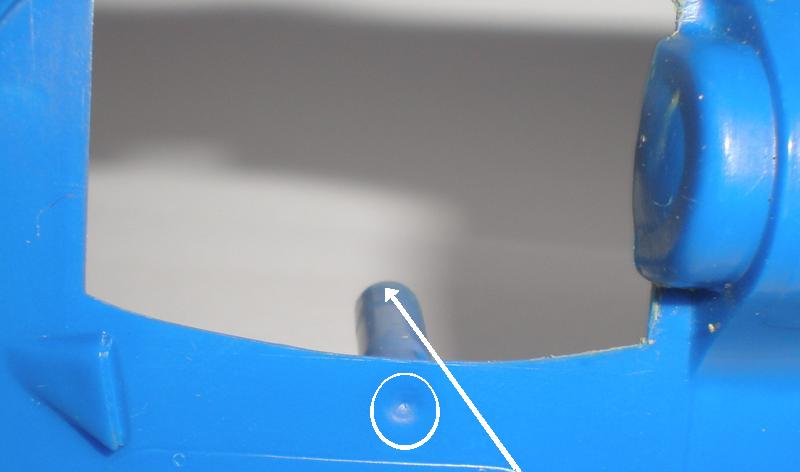
A sink mark, and in a place were they often occur. The long pillar that supports the body holds a lot of plastic, this shrinks during cooling leaving a depression. This is more common on cheaper, less well engineered, kits.
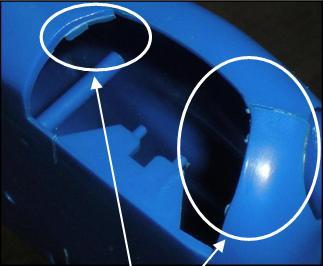
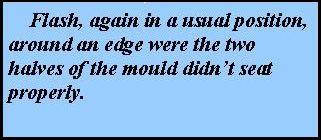
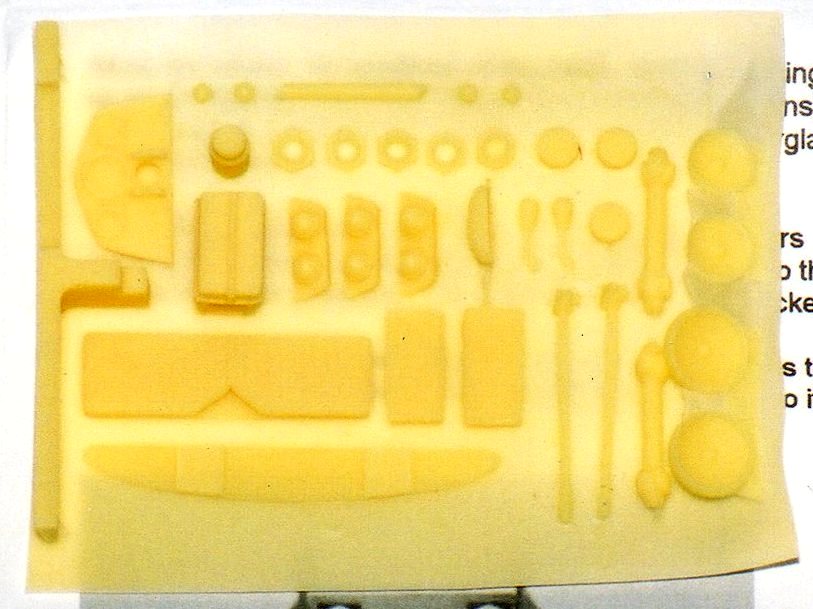
Flash, this time on parts from a resin kit. It is easily trimmed off and sanded down. For more information on building a resin kit go to our article on the 1972 le Mans Matra resin kit build.
Attend to each of these defects as you find them, models look much more realistic if they don’t have mould lines and holes in them. Some times you can ignore them if they won’t be visible on the finished model, why make extra work for yourself.
All the parts, large and small need to be cleaned up so they will all look more realistic. Each part will have a mark where the mould halves line up and this needs to be smoothed out, usually with simple sanding but sometimes with the use of filler. As I mentioned earlier the end result is directly linked to the amount of time and effort put into the model. Particularly in the preparation stages.

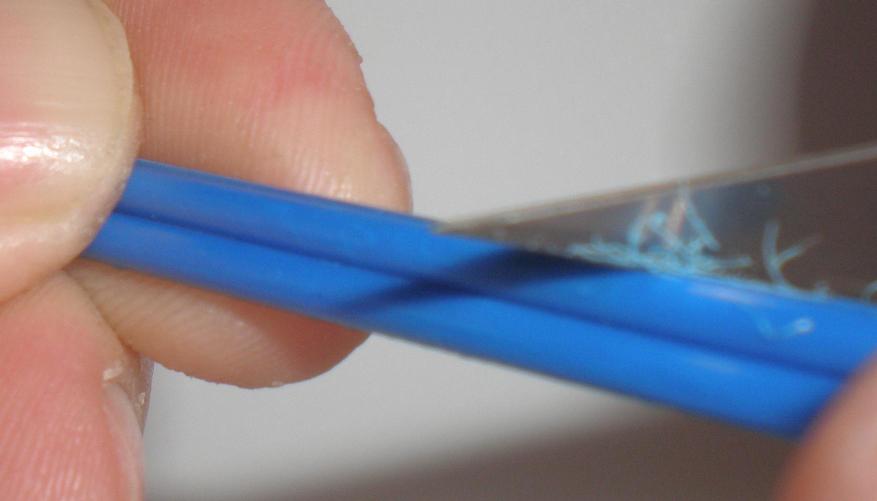
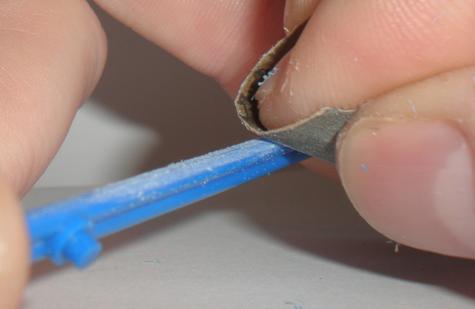
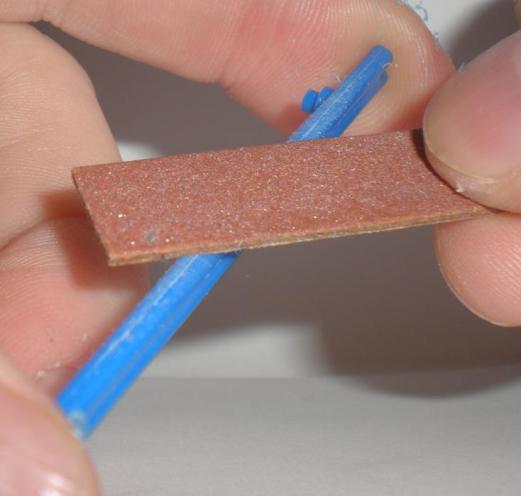
A gentle scraping with a knife, keeping the blade angled away from you, will take down most of the surplus plastic. However you must be careful to maintain the round section of the tubing. We move on to sanding sticks and abrasive papers, step by step, to remove the rest of the plastic and take care of unwanted scratches.

Sanding and filing.
An Emery board, nail file or wet and dry sand paper will be more than enough to get you started. Emery boards are cheap and easily available, almost all the female members of your family will have an emery board or nail file! A set of sheets of wet and dry, usually sold as two or three sheets of fine, medium and coarse, will take care of your sanding needs for years to come. Available at any DIY or motor store.
When you need to remove a large amount of flash or sprue joints use the knife to remove most of the excess, followed by sanding with an emery board then fine sand paper to finish off.
Follow a similar process to remove mould seem lines on all parts and any un-needed projections that can occur at mould ejector points.
In the future you may wish to purchase a set of files for your model making, these can be very useful. You can find them for sale on the internet, at model shows and in hobby & DIY stores.
Shown here are three sets of files. The difference in size is clear between sets and you can even get micro files sets which are very small. Also available are the angled files to get into difficult places.
Filing and sanding produce waste material in large quantities, care must be taken not to breath in any dust. Keep your work area clean and free from things that could spoil your paint finish.
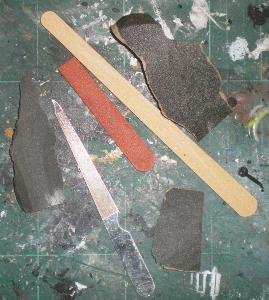
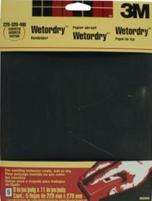
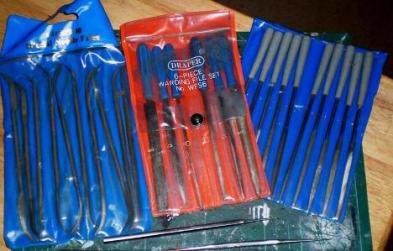
Fillers.
If you need to fill a sink hole or hide a join in the body work, you’ll need some fillers. There are many types of fillers available that can be used in model making. The straight forward plastic fillers like Humbrol model filler or Squadron green or white putty, are specifically used for filling gaps and blending joints on plastic models. These tend to be slow curing and can eat into the surrounding plastic area if over applied.
For resin and metal kits you can use two part epoxy putties such as milliput, Isopon 38 or any of the many different products available from hobby and DIY stores. Some of these can also be used, with care, on plastic kits. Some are very good for getting strong smooth joints. Milliput can be smoothed and worked, with a wet cloth or tool, to give very smooth finishes or be scribed or moulded. Isopon 38 dries quickly and sands easily so doesn’t slow the model building process as much, while still giving a strong bond.
Superglue, or cyanoacrylate (ca), can also be used for filling and there are products like Zap-a-gap that are specifically designed for this job. Normal super glue and a spray, or brush applied, accelerant to speed up drying time work similarly to Zap-a-gap. In both cases you must work at the time as if you wait till the next day to start filing and sanding the superglue dries much harder than the surrounding material making it hard to got a smooth finish without damaging the surrounding area. Super glue also gives off fumes that can adhere to finger prints and can ruin clear or chromed parts if used near to them. Protecting these parts with a coat of Johnsons Klear will help guard against this problem.
The one thing all these fillers have in common is that they are going to sit on top of the plastic. To make the best bond to the plastic kit parts one needs something that bonds itself to the plastic and will never shrink. A good way to meet this need is to put some chopped up old sprue into an old bottle of liquid glue and let them dissolve. With a little experimenting you can create a sort of “sprue soup” that when applied to the plastic parts dissolves the kit plastic a little so it literally becomes part of the plastic. You can sand, file and paint it the same way you would the rest of the kit.
We use several of these products depending on the job requirement. Read through our articles and you will find more on what we use, when, and why.
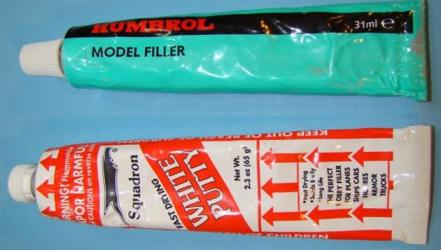
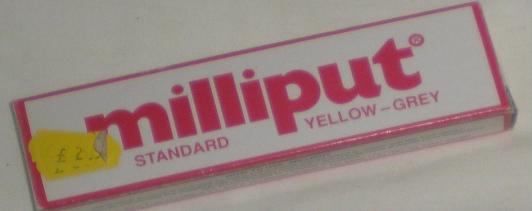
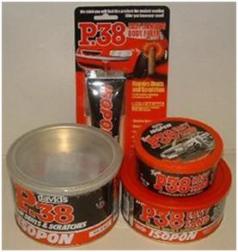
The sink marks in this Jaguar were filled with Isopon 38. The body was then sanded, primed, sanded, painted, sanded, painted and sanded again before final painting and polishing. The filler was also used to blend in the new windscreen and mirror fairings.
The paint is stripped back and sanded down, and Isopon38 is mixed and filled into the sink marks.
After sanding back the fillers and putting on a few coats of primer and sanding them, the first coats of body colour have been applied and sanded back. Building up the body colour patiently is important.
Here the body colour is ready for final sanding and polishing, the sink marks are gone and the car already looks more real.
The finished car and no sign of those sink marks or the fillers. Patience is more than a virtue!
Forming two balls the same size is the easiest way to mix milliput in equal parts. This was used to fill the deep holes in this fire fighter figure, smoothed with a wet figure to push it into the holes but not obliterate the folds in the clothes.
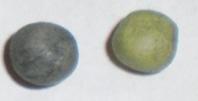
Follow onto page two to start the building of sub-assemblies,storing them during the build and for information on glues.
